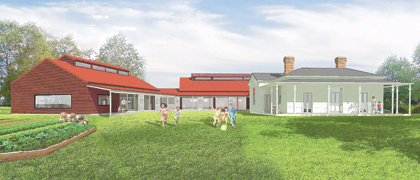The old lady of the landscape, 116-year-old Guy Homestead, has new owners who want to give it a new lease of life, with the fresh breath of preschoolers. MARIANNE KELLY meets the new owners.

FOR the past 15 years, JP Singh has regularly driven past the historic Guy Homestead in Ti Rakau Drive and pondered about ways of returning it to its heritage roots.
He and his business partner Kuljet Singh are now going to turn a dream into reality with restoration of the burnt-out homestead and its conversion to a child care centre.
They have paid close to the $3.5 million asking price for the property and hopes are high that in 12-15 months children will enter the doors of the Piccolo Park Family Learning Centre. Preliminary work on the building started this week.
Under a newly-established name, Ti Ranga Aotearoa Group of Companies, the Singhs have multiple interests, including developing child care centres and hospitality projects.
They became aware of the homestead in 2003 when they built and, for the first few years, operated the Xtreme Entertainment Centre on the corner of Ti Rakau Drive and Botany Road.
“I remember seeing the real estate sign on the fence in perpetuity, and when circumstances allowed I chose to gather the courage to have a chat with my bank to speak to them about the implications,” says JP Singh.
“We were faced with the challenges of dealing with an overseas vendor who had lost a bit of interest in restoration.
“The vendor had fixed demands, but the Auckland Council was looking outside the square, refreshingly so.”
The concept of converting the property into a child care centre was not far from the minds of council officials, who had been given the go-ahead by councillors and the Howick Local Board to put an offer in for the homestead.
They, like real estate agent Lawrence Wong, who had been marketing the property for the best part of 10 years, were hamstrung by the NZ Historic Places Trust and former Manukau City Council covenants.
They protected the homestead from being removed from the site and required restoration projects to retain its architectural style.
Another covenant restricted the land, zoned residential, from being subdivided.
Historically, JP Singh says: “There was bad blood and an element of mistrust about the way the encumbrances were written.
“Then with the fire gutting the building and the presence of the encumbrances, the vendor felt there was a bone of contention.
“We didn’t go down that path. We decided to take the encumbrances in spirit, embrace the limitations and run with it.
“We could have opted for one-and-a-half times the space for the child care centre.
“But the option to carry on with the legacy of the homestead prompted us to scale the model back to 120 children, when it could have been up to 180.
“That was the turning point and then we could go forward.”
The result was a deal between developer and council that the land at the back of the property could be subdivided, but the homestead must be restored.
Council heritage manager Noel Reardon says when the Auckland Council was established it found Guy Homestead on a list of privately-owned heritage buildings deemed to be at risk.
“It was a case of demolition by neglect. We have a number like this around the city and this one was exacerbated by the fire, although it looked worse than it really was.
“But we were trying to deal with it under a regulatory framework which was frustrating.
“We found the mechanisms on the title were inadequate and we were dealing with an overseas owner.
“There was a lot of public interest and I was getting weekly calls from people asking about what progress was happening.”
When JP Singh approached the council, it was considering purchasing the property. But the offer had to be cost-neutral, so it was considering uses for the site similar to the Singhs.
“When we discussed the homestead with Mr Singh we found he not only valued the heritage and had a proven track record, but also a similar idea to that the council had chosen. We were extremely happy,” says Mr Reardon.
The council, he says, found the encumbrance about maintenance of the homestead was unenforceable. But preventing subdivision was enforceable. So, through the resource consent process, it was able to tweak the system.
“The subdivision issue was the lever that we believed could be addressed.”
The upshot is the establishment of two base lots of 2000 square metres and 1800 sq m at the rear of the property, now on the market for subdividing.
The resource consent also allows the new owners to shift the homestead 8m to the north-west, maintaining the central vista, but allowing for a barn-like swing of building behind the homestead.
“The problem was that regulatory mechanisms are black and white, while on the ground nothing is,” Mr Reardon says.
“That led to the negotiations and we’re happy about the flexibility. The homestead is a landmark and it had to be visible from the road, restored and reused.”
• Known also as Saidia House, Guy Homestead was built in 1898.
It was originally part of a 210-acre farm and over the years was subdivided into smaller property parcels.
The former Manukau City Council bought it and 0.9 hectares in the early 1980s to allow for the extension of Ti Rakau Drive.
The council sold the property in 1997 and private owner, Hong Kong-based Twin Oaks Ltd, settled on the property sale with the Singhs on January 13.









